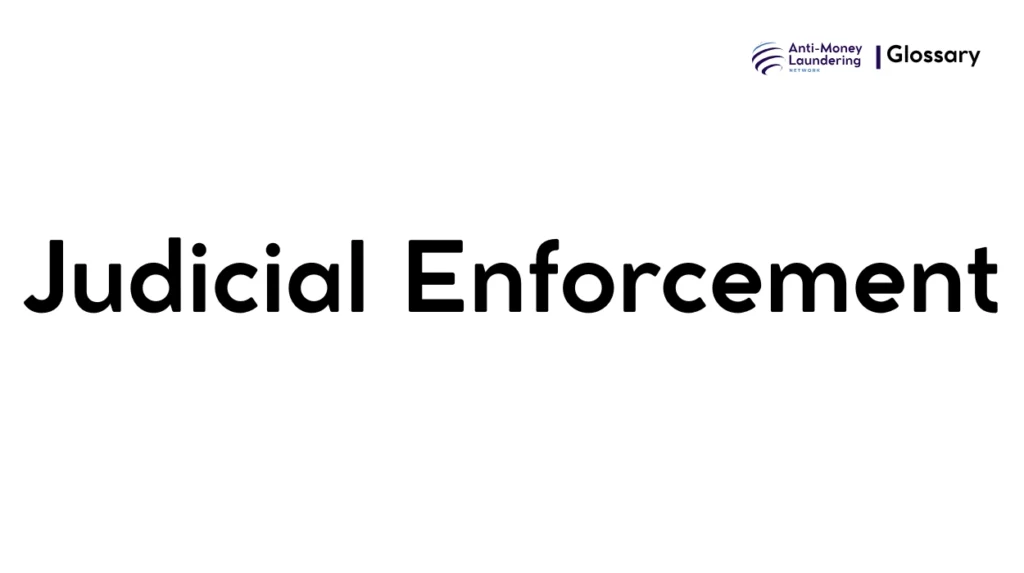Definition
Judicial enforcement in AML refers to the process by which courts and judicial authorities apply laws, impose sanctions, and oversee legal proceedings related to breaches of anti-money laundering regulations. It encompasses the formal legal actions taken to enforce compliance, prosecute offenders, and uphold AML laws to prevent the laundering of illicit proceeds.
Purpose and Regulatory Basis
Role in AML
Judicial enforcement ensures that AML regulations are not just advisory but legally binding. It serves to:
- Deter financial crime through credible legal consequences.
- Punish violations effectively via courts.
- Uphold the integrity of financial systems by legally sanctioning offenders.
Key Global and National Regulations
- FATF Recommendations: The Financial Action Task Force (FATF) sets global AML standards emphasizing effective enforcement frameworks.
- USA PATRIOT Act: Enhances judicial powers for AML enforcement and enhances detection/prosecution of money laundering in the U.S.
- EU AML Directives (AMLD): Require member states to implement judicial mechanisms for AML compliance and enforcement.
These frameworks mandate countries to empower courts and judges to take decisive action in AML cases.
When and How it Applies
Real-World Use Cases
- Prosecution of individuals or entities suspected of laundering proceeds.
- Judicial orders for asset confiscation or freezing during AML investigations.
- Enforcement of penalties or remedial orders against financial institutions failing compliance.
Triggers
- Detection of suspicious transactions or patterns.
- Failure to comply with regulatory AML requirements.
- Initiation of criminal investigations revealing money laundering activities.
Types or Variants
Criminal Proceedings
Prosecutions where judicial authorities seek conviction and punishment for AML offenses.
Civil Enforcement
Court orders imposing fines, sanctions, or corrective actions without criminal charges.
Asset Forfeiture and Freezing
Judicial acts to seize or freeze assets believed to be proceeds of crime.
Judicial Review of Regulatory Actions
Courts may review enforcement actions initiated by regulators to ensure legality and fairness.
Procedures and Implementation
Institutional Steps for Compliance
- Detection & Reporting: Institutions identify suspicious activities and file reports.
- Investigation: Judicial authorities receive evidence from regulators/law enforcement.
- Prosecution/Proceeding: Courts hear cases, evaluate evidence, and issue rulings.
- Sanction/Remediation: Courts impose penalties or corrective orders.
Controls and Systems
- Establishing case management systems linking financial intelligence to courts.
- Training judicial staff on AML law nuances.
- Collaboration frameworks between regulatory bodies, prosecutors, and judges.
Impact on Customers/Clients
- Rights: Access to fair trial, legal representation, and appeal.
- Restrictions: Freezing of accounts, asset seizure, or transaction limits during proceedings.
- Interactions: Must respond to judicial inquiries and comply with court orders.
Duration, Review, and Resolution
- Judicial enforcement proceedings may last from months to years depending on case complexity.
- Regular review and hearings occur to assess evidence, compliance, and potential resolution.
- Ongoing obligations for institutions/clients may persist beyond case closure, such as enhanced monitoring.
Reporting and Compliance Duties
- Institutions must maintain meticulous records to support judicial processes.
- Prompt reporting of suspicious activities triggers judicial action.
- Failure to comply with judicial orders can result in harsher sanctions, including criminal charges.
Related AML Terms
- Suspicious Transaction Reporting (STR): Initiates judicial review.
- Financial Intelligence Unit (FIU): Supplies information for judicial processes.
- Asset Freezing and Forfeiture: Legal tools within judicial enforcement.
- Regulatory Enforcement: Regulatory bodies act before judicial proceedings commence.
Challenges and Best Practices
Common Issues
- Delays in judicial proceedings impacting enforcement effectiveness.
- Jurisdictional challenges in cross-border AML cases.
- Limited expertise in complex financial crimes among judiciary.
Best Practices
- Continuous AML training for judicial officers.
- Enhanced cooperation between international judicial bodies.
- Use of technology for case tracking and evidence management.
Recent Developments
- Increasing use of digital evidence and forensic technology in court.
- Judicial cooperation frameworks in transnational AML enforcement.
- Strengthened legal mandates post recent FATF evaluations and global AML reforms.
Judicial enforcement forms the backbone of effective AML regimes, transforming regulatory requirements into actionable legal consequences. Its robust implementation safeguards financial systems by ensuring violations are met with fair, transparent, and firm judicial actions. For compliance officers and financial institutions, understanding judicial enforcement is essential to navigate regulatory landscapes and foster AML compliance.

